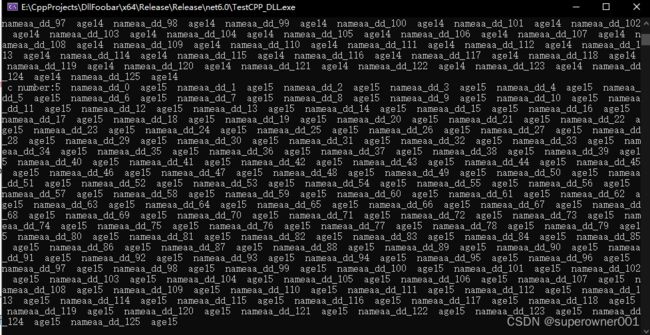【C#与C++结构体数组互相传递】
应该是目前网上能看到的思路最清晰的版本了!
首选是CPP端,把以下编译为dll
#pragma warning(disable:4996)
#include 第一个函数ExportClass:用于传入一个空指针的地址,在函数内部重新对它实例化并赋值,num为最终获取的对象个数,因为c#端是不知道的!
第二个函数ImportClass:用于传入一个C#端过来的指针,长度(num)由C#端决定,同理,这个时候CPP端也不知道指针指向数值长度
C#端:
using System.Runtime.InteropServices;
[StructLayout(LayoutKind.Sequential)]
public struct Student
{
[MarshalAs(UnmanagedType.ByValTStr, SizeConst = 20)]
public string name;
public int age;
[MarshalAs(UnmanagedType.ByValArray, SizeConst = 32)]
public double[] scores;
}
[StructLayout(LayoutKind.Sequential)]
public struct Class
{
public int number;
[MarshalAs(UnmanagedType.ByValArray, SizeConst = 126)]
public Student[] students;
}
public class ddd
{
[DllImport("DllFoobar.dll", CallingConvention = CallingConvention.Cdecl)]
public static extern void init(ref int num);
[DllImport("DllFoobar.dll", CallingConvention = CallingConvention.Cdecl)]
public static extern int ExportClass(ref IntPtr pclasses ,ref int num);
[DllImport("DllFoobar.dll", CallingConvention = CallingConvention.Cdecl)]
public static extern int ImportClass([In, Out] Class[] classes, int num);
unsafe static void Main()
{
int num = 0;
int size = Marshal.SizeOf(typeof(Class));
IntPtr infosIntptr = IntPtr.Zero;// Marshal.AllocHGlobal(size * 50);
//Class[] infos = new Class[50];
ExportClass(ref infosIntptr,ref num);
Console.WriteLine("infosIntptr:"+ infosIntptr);
//ExportClass(classes,ref num);
for (int inkIndex = 0; inkIndex < num; inkIndex++)
{
IntPtr ptr = (IntPtr)(infosIntptr.ToInt64() + inkIndex * size);
var dd = (Class)Marshal.PtrToStructure(ptr, typeof(Class));
Console.WriteLine(dd.number+" "+dd.students[0].name);
//break;
}
Console.WriteLine("num:"+ num+ " infosIntptr:" +(infosIntptr!=IntPtr.Zero));
Marshal.FreeHGlobal(infosIntptr);
/
int c = 6;
Class[] classes=new Class[c];
for (int i = 0; i < classes.Length; i++)
{
classes[i].number = i;
classes[i].students = new Student[126];
for (int s = 0; s < 126; s++)
{
classes[i].students[s].name = "aa_dd_"+s;
classes[i].students[s].age = i + 10;
}
}
ImportClass(classes,c);
Console.ReadKey();
}
}
PS:
这里ExportClass内由于第一个参数CPP端是一个二级指针pclasses,所以对这个指针提取地址,也就是 ref IntPtr pclasses,即指向指针的指针,由于这个指针是在CPP里面实例化的,所以整活完后需要手动在C#端释放内存;
第二个函数就比较直观了,通过特殊的定义[In, Out] Class[] classes传入数值到CPP里
Ref
https://blog.csdn.net/fenggewan/article/details/88409551
https://www.jb51.net/article/103825.htm
https://blog.csdn.net/bruce135lee/article/details/80952032

